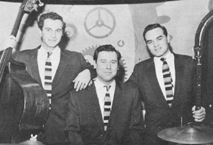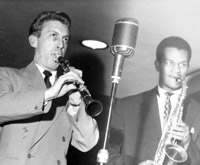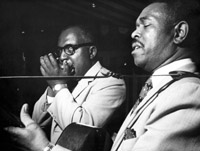 |
|||||||||||||||||||||||||||||||||||||||||||||||||
 |
|||||||||||||||||||||||||||||||||||||||||||||||||
| This is an edited and updated version of an essay written by Peter Clayton for tour programmes in the mid-1960s, and reproduced by Gerard Bielderman and Julian Purser as the introduction to their discography, A Life in Music: Chris Barber Discography 1949-2001. To hear some of the story in Chris's own words, go to the Miscellaneous page ("Concert Introduction"). On this page you will find Part One of the Chris Barber Story, more or less as it appeared in the first edition of the discography in 1965. Part Two is a 2004 update, giving an overview of some of the main changes that occurred in the band from the mid-60s until the formation of the Big Chris Barber Band in 2001. Subsequent parts will fill in some of the detail not covered in Part 2, and will extend the story to the present day. |
|||||||||||||||||||||||||||||||||||||||||||||||||
A closer look will reveal an orderly principle underlying all this confusion, for like an amoeba, which multiplies by splitting into two parts, and each part into two again, jazz bands have been dividing and multiplying since before Buddy Bolden shaved his last customer! A band is formed. It does well or not, as the case may be. Sooner or later somebody decides to leave, or is thrown out. Either way, the result is the same -- a new band starts to form around him and the whole process begins over again. The result of this process is that jazz groups in general are seldom in existence long enough to acquire a corporate life of their own. In a world where even two years is a long time for any aggregation of musicians to stay together, the exceptions tend to be conspicuous. In America, one immediately thinks of Duke Ellington and then of Count Basie; in Britain, of Chris Barber. TAKE OFF
PROPULSION
While remaining a convinced traditionalist Chris believes that there is room for development within traditional jazz and has succeeded in retaining the principles of the traditional style, while achieving a sound clearly recognizable as one of today and not of yesterday.
The rhythm section is a case in point. Starting with the instrumentation of the earliest New Orleans bands, with banjo, bass and drums, and no piano, the band evolved a "modus operandi" which, paradoxically, draws on the experience of modern jazz groups. The section tends to pivot around the bass, rather than the banjo or bass-drum, and the fact that Chris himself has also studied bass may have some bearing on this.
It is the role of the clarinet in the band which has undergone the least change from the New Orleans conception. It is also noticeable that the clarinet, in recent years, is the one jazz instrument whose development seems to have stopped, even among modernists. After the departure of Monty Sunshine in December 1960, Ian Wheeler joined from the Ken Colyer band, and brought with him a fluent and accomplished clarinet style very close to the original New Orleans conception; less conventionally, he brought along an alto saxophone. The band had been frequently joined in performances by alto-sax players ever since the Ken Colyer days of 1953, when Joe Harriott first sat in with great success. Subsequently, the band had been joined by Joe Harriott, Bertie King, and Louis Jordan on record. Ian's firm, pushing alto has given the chance to develop, in appropriate numbers, a more solid ensemble sound and has greatly improved many of the more-arranged pieces featured by the band. The singing of Ottilie Patterson has been a strong propulsive element in the band's performance and development since she joined in 1955, and the band's style of performance has frequently been affected by its experience of vocal accompaniment. One very telling factor on which any jazz group's style depends is the self-discipline of the members while improvising together, and this is felt most clearly when accompanying a solo artiste. The band's success in this direction is no less due to Ottilie's deeply felt and well-phrased singing than to their own talent. Ottilie herself, with aims similar to Chris's, has retained the best elements of old-style blues singing and combined them with aspects of present-day blues to achieve an individual blues style. TREND SETTING It has been the Barber band's lot to pioneer things, not consciously like mountaineers or gold-prospectors, but through a sort of innate flair for producing new sounds and effects which later spread throughout British jazz. Not least was the chance adoption of a piano-less rhythm section, and the resulting creation of the much maligned British "trad" sound - and all because there was not a pianist around at the time! Two other facets of the band's original performance were to leave their marks not only on the British jazz scene but also on the broader scene of entertainment.
The honours of the first trend-setting achievement of the Barber band fell to Monty Sunshine. In 1956 he recorded a solo performance of Bechet's "Petite Fleur" which, when released as a single in 1959, earned the band two more gold records. "Petite Fleur" was indeed clearly the progenitor of success of many semi-pop clarinet features, notably "Summer Set" and "Stranger on the Shore" by Acker Bilk. What promises to be another trend set by the Barber band is the current interest in rhythm and blues. Naturally enough, through Ottilie's interest in this idiom, the band was led to tackle, as long ago as early 1959, music outside the strictly traditional field in yet another direction, and to call upon the services of Alexis Korner on electric guitar and Cyril Davies on harmonica in 1961. In 1962 Korner and Davies formed their own R&B group, which has since -- amoeba-like -- split up into other groups. The development of an R&B style by the traditional jazz band of Chris Barber was, without doubt, given greater impetus by their association with numerous great American artists. GUIDING STARS
The Barber band have always been known for experimenting with something which later catches on. These moves forward have often been connected with singers, either from inside the band itself or, more frequently, from close association with American jazz vocalists. First came Big Bill Broonzy, giving the band their first live taste of genuine blues. Bill's personality and singing moved the band to a tremendous extent and his death brought a feeling of personal loss to everyone. With Broonzy came Brother John Sellers, giving the group more of a "city blues" influence and also a hardly noticed hint of gospel music. The band's great interest in gospel style was really kindled by Sister Rosetta Tharpe, whose performances with the band and Ottilie in 1957 were so electrifying for all concerned. Sister's inspired singing was to pull Ottilie with a jerk from her concentration on early blues style singing. The next visitors were Brownie McGhee and Sonny Terry, whose playing helped to make concrete the rhythmic ideas, particularly the "triplet style" already learned from Sister Rosetta. In late 1958 came a visit which was to lead to the band's first taste of the real blues in its own environment. The artists in question were Muddy Waters and Otis Spann; the tour with them in England was exciting enough, but the subsequent encounter in Chicago (on the band's first United States tour) with Muddy's full blues band was earth-shattering in its impact. No one who heard Muddy's band at that time will ever forget the sound, feeling, and rhythm which filled "Smitty's Corner" every night. To Ottilie, it was almost a traumatic experience, at last she had heard, in its original habitat, the music to which she had been devoted for years. To the band, it gave a whole new dimension in blues playing and an experience nearly as emotional as it gave to Ottilie. The adoption of the off-beat style of Chicago-style blues enabled the band to break the sound barrier of strict New Orleans phrasing which had in any case never contributed to the development of Negro vocal blues. It was the same Chicago blues style coupled with Negro gospel music which, in popularized form, became rock and roll. The Muddy Waters band of 1959 broke up in 1961 (in the time-honoured way) and his ex-harmonica player, now leading his own group, was Chris's next United States guest. Jimmy Cotton enthralled listeners, by now becoming accustomed to the Chicago sound, at Beaulieu in 1961 and on tour around England.
Creole clarinettist Edmond Hall toured with the band in Europe in November 1962 and Ian Wheeler soon showed signs of developing a hotter, more direct clarinet style. One of the greatest of the band's guests was Louis Jordan, who came to England in December 1962 and stung the band into unprecedented activity. This tremendous artist was heard with the band on the radio and in several unforgettable concerts. (You can read about the records that the Barber Band made with Louis Jordan, view a concert programme and other publications, and listen to some music if you begin at The Best Of Both Worlds, Louis Jordan & Chris Barber, or Jazz Lips.) More recently, American blues artists Sonny Boy Williamson, Jimmy Witherspoon, Howling Wolf, Memphis Slim, and Little Walter have been featured with the band. The precise effect of these tours remains to be seen, but what is certain is that these trips will have contributed their due portion of progress and enlightenment to this highly receptive band. IN ORBIT The influences have not all been one way. For the Barber band, which spends something like half its time travelling about Europe and America, does so at the invitation of other jazz organizations. Only a band with truly international stature could survive at festivals like those at Monterey and Washington.
Eminent American jazz critic, John S. Wilson, probably summed up the situation neater than anyone else when he wrote in the New York Times: "The fascination that home-grown 'traditional' jazz bands holds for the English jazz follower was explained last night at Town Hall by the appearance of Chris Barber's band. Mr Barber's group plays a form of disciplined, yet full blooded and buoyant jazz that is definitely superior to that of any equivalent band in this country. As a matter of fact, there is no equivalent band in this country for Mr Barber and his men have created a metier that is unknown over here." |
|||||||||||||||||||||||||||||||||||||||||||||||||


















